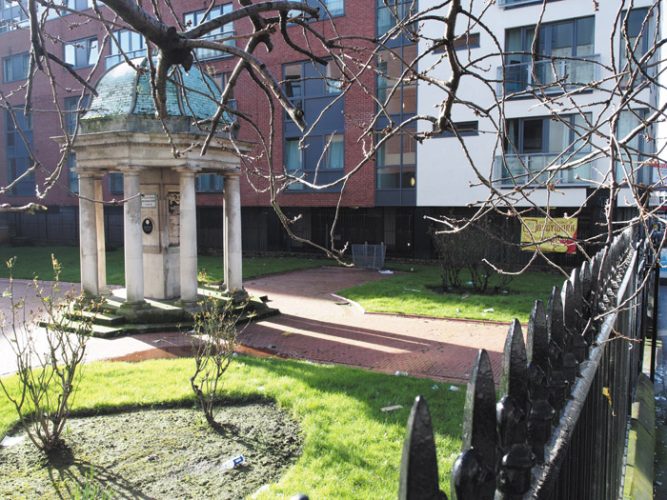Has Liverpool and Britain always been a land of immigration?
By Anthony McCarthy from PIPS (Philosophy In Pubs, Liverpool)
Photo above by Steve Lamb of Roscoe Gardens, the burial place of Joseph White
Britain has always been a land of immigration. The Iron Age Celts arrived and then the Romans. We know that, in 250 AD, a group of ‘black legionnaires’ stood guard on Hadrian’s Wall. It must have been a culture shock for them, from the weather point of view, at least.
Next came the so-called Dark Ages (5th Century) and the Angles and Saxons arrived from what we now call Germany. The pivotal year of 1066 saw the arrival of the Normans and a wholesale change in the prevailing culture of the land of Britain. Many of these changes (law and administration) were for the better.
It is hardly necessary to mention the Vikings in the Liverpool area (c. 900 AD) because they still have a massive genome trace on the Wirral.
African drummers were in Edinburgh in 1505. The local people found their ‘strange’ percussive sounds fascinating. Outsiders have always contributed to art in Britain and the West in general. Rock and roll had its roots in African music, for example.
Not all ethnic groups fared well under British law: in 1562 Queen Elizabeth I passed The Egyptian Act. The latter was an attempt to control immigration of Gypsies into the country. As usual, the host country wanted to cherry-pick skills from its immigrants. Weavers from the Low Countries were a highly prized work-force in the 14th Century onwards because of the vast quantities of money to be made from textiles.
It is said that in 1440 there were 16,000 foreigners in Britain out of an estimated population of 2.5 million. This suggests that actual numbers of immigrants into this country have been historically low, but tended to be exaggerated.
The first piece of modern immigration-specific legislation in Britain was passed in 1905. It was in response to increasing numbers of Eastern Europeans landing in London, where poverty and lack of jobs were already perceived as massive problems for the locals. The Act stipulated that there was no automatic right of entry, and that would-be immigrants had to prove they could financially maintain themselves and be of previous good character.
So, as stated above, Britain has always been a land of immigration. It would be quite difficult to define, ethnically, what a Briton was because of the wide-ranging historical inputs into the population.
There were political and social milestones, too. Britain’s first non-white MP appeared in 1892 (an Indian called Dadabhai Naoroji); and the first non-white professional footballer, Arthur Wharton, played in an FA Cup Final for Preston North End in 1887.
Liverpool played a big role in welcoming the French Huguenots into Britain. The Huguenots were fleeing religious persecution. There is a record in St. Nicholas Church, Liverpool, of one of its rectors (William Atherton: 1657-1706) organizing fundraising events to help the newcomers. By the way, Atherton had been a curate in Kirkby (now in Knowsley).
Here are two Liverpool immigrants. They should be much better known, both locally and nationally. They arrived in Liverpool after political struggle, adding a lot to the educational and artistic development of Liverpool.
In 1823 Anthony Panizzi (1797-1879) appeared in Liverpool. Panizzi had fled Italy as a political refugee. He settled in Liverpool and worked as a teacher of Italian until 1828. His innovations in language teaching were very popular in the city. He made language learning much more active and accessible for all levels of ability. Panizzi moved to London in 1828 and worked as Professor of Italian in University College until 1831.
He wrote a grammar of Italian during his time there. In 1831 he became a librarian in the British Museum. In 1859 Oxford University awarded him a DCL (Doctor of Civil Law). Panizzi is not as well-known as he should be. He did a lot to promote education in Liverpool. He arrived in the city with nothing but went on to find fame and some fortune through his own efforts.
Joseph Blanco White (1775-1841) is another man who should be much better known in Liverpool. He was a political journalist and arrived here from Spain c. 1808, seeking asylum from Napoleonic invaders. Actually, Blanco had an English father but had lived in Spain most of his life. He was active as a poet in Liverpool and wrote his most famous piece in 1828, Night and Day. He was very active in the church in Liverpool (Unitarian) and was involved in useful charity work. Thousands of Liverpudlians pass his grave every day without a clue that they are doing so. He is buried in Roscoe Gardens at the foot of Mount Pleasant.
I would like to finish this article by mentioning another great ‘refugee’- the ancient Greek philosopher, Diogenes of Sinope (412 BC-323 BC). When landing in a foreign place, he was asked what his nationality was. He answered famously: “I am a citizen of the world.” He saw ‘nationality’ as a legal fiction, a piece of paper. He felt the whole world belonged to everyone, equally.
A similar thing happened to Captain James Cook in Australia (1728-1779). One day Cook was busy drawing a map. A group of Aborigines looked at his map and then exclaimed: “We have never seen lines on the ground before.”
The Aborigines saw the map as an artificial thing; it had no counterpart in nature.
Centuries later an Aborigine elder came to Britain. He went to the beach in Brighton. He planted an aboriginal flag into the sand, to the astonishment of the people on the beach, and said: “I claim this land for the Aboriginal peoples of Australia.”
Everybody laughed. He gave them a serious look and said: “This is all you did in Australia.”
The last word goes back to a paraphrase of the idea of Diogenes: birds migrate without let or hindrance. The world is for everyone.
